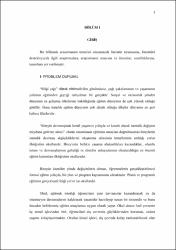| dc.contributor.advisor | Ergün, Mustafa | |
| dc.contributor.author | Yüksel, Aslı | |
| dc.date.accessioned | 2015-03-25T13:05:04Z | |
| dc.date.available | 2015-03-25T13:05:04Z | |
| dc.date.issued | 2005 | |
| dc.date.submitted | 2005 | |
| dc.identifier.uri | http://hdl.handle.net/11630/3330 | |
| dc.description.abstract | Araştırmacı, yaptığı bu araştırmasında İlköğretim I. Kademe 1., 2. ve 3. sınıflarda görülen istenmeyen öğrenci davranışlarının sınıftaki öğrencilerin yüzde kaçında görüldüğünü ve öğretmenlerin bu istenmeyen öğrenci davranışları ile baş etmek için en çok hangi yolları kullandığını belirlemeyi amaçlamıştır. Önce araştırmanın temelini oluşturacak konuyla ilgili literatür taraması yapılmış, ilgili araştırmalar gözden geçirilmiş, başlık ve alt başlıklar oluşturularak araştırmanın teorik kısmı tamamlanmıştır.
Araştırma genel tarama modelinde yapılmıştır. Araştırmanın çalışma evrenini, 2003-2004 eğitim öğretim yılında Afyon Merkez İlçeye bağlı 41 İlköğretim Okulunda görev yapan 94 birinci sınıf , 89 ikinci sınıf ve 87 üçüncü sınıf öğretmeni olmak üzere toplam 270 öğretmen oluşturmuştur. Evrenden random (rastgele) tekniğiyle seçilen toplam 114 öğretmen (19 okuldan 6’şar öğretmen) araştırmanın örneklemini oluşturmuştur. Araştırmacı tarafından hazırlanan 25 istenmeyen öğrenci davranışı ve 8 çözüm yolundan oluşan anket formu, İlköğretim I. Kademede görev yapan 1., 2. ve 3. sınıf öğretmenlerine uygulanmıştır. Araştırma sonucunda elde edilen veriler SPSS 10 for Windows paket programından yararlanılarak değerlendirmeye tabi tutulmuştur. Öğretmen görüşleri ile değişkenler arasında anlamlı bir farklılığın olup olmadığını belirlemek için yüzdeliklerden ve Ki-kare testinden yararlanılmıştır.
Araştırmada şu sonuçlara ulaşılmıştır:
Öğretmenlerin belirlediği istenmeyen öğrenci davranışlarının başında “Konuya, işe ya da çalışmaya dikkatini toplayamamak”, “Bir yerde uzun süreli oturamamak” ve “Derste sıraların arasında dolaşmak” davranışları gelmektedir. Bunun yanında “Verilen ödevleri eksik yapmak ya da hiç yapmamak”, “Derse aktif olarak katılmamak, başka şeylerle meşgul olmak”, “Kavga etmek” ve “Sürekli arkadaşlarını şikayet etmek” gibi davranışlar da öğretmenlerin en çok şikayet ettiği davranışlardır.
En fazla görülen istenmeyen öğrenci davranışlarının bile sınıfın % 12-13’ünde görüldüğü, dolayısıyla araştırma yapılan İlköğretim Okullarındaki öğrencilerin % 90’ında rahatsız edici bir davranış görülmediği ortaya çıkmıştır.
En çok görülen istenmeyen öğrenci davranışlarının (Konuya, işe ya da çalışmaya dikkatini toplayamamak, Bir yerde uzun süreli oturamamak) öğrencilerin % 10-19 aralığında görüldüğü; diğer tüm istenmeyen öğrenci davranışlarının % 1-9 aralığında görüldüğü tespit edilmiştir.
İstenmeyen öğrenci davranışlarıyla baş etmede genellikle öğrenciyi uygun bir dille uyarma, olumlu davranış gösteren öğrenciyi örnek gösterme ve öğrenci ile dersten sonra konuşma (bazen de öğrencinin ailesine haber verme) yolları tercih edilmiştir. Görmezden gelme, öğrenciye bağırma, öğrenciyi bedensel olarak cezalandırma gibi yollar öncelikle tercih edilmemiştir. | en_US |
| dc.description.abstract | The researcher in this study aims at determining the numbers of students who show misbehaviors and the kind of methods the teachers use for students with misbehaviors and the way they approach these students in the classrooms. First, the literature review is presented through exploration of related studies. Then, the theoretical aspect of the study is completed.
This study is conducted as a descriptive model. In 2003-2004 education year, the sample of ninety-five 1st grade, eighty-nine 2nd grade and eighty-seven 3rd grade teachers, the total of 270 teachers, were chosen from 41 Elementary schools in Afyon for this study. 114 teachers (6 teachers from 19 schools) were chosen through random sampling. The survey, prepared by the researcher, is composed of 25 misbehaviors and 8 different solution ways and was conducted to randomly selected 1st, 2nd, and 3rd grade teachers in elementary schools. The data results were evaluated in SPSS 10 for Windows packet program. In order to determine any meaningful significance between teachers’ views and variables, percentages and Chi-Square test were used.
It has been concluded that teachers stated three different misbehaviors: 1.“students cannot focus on the lesson”; 2.“students often move and distract the attention in the classroom”; and 3.“students cannot sit longer in their desks”. Furthermore, teachers complained that “students do not do their homework or complete them”, “do not participate in class activities” and also “they get into fight “and “lodge a complaint about their classmates.”
The percentage of the most misbehavior was observed only 12-13% in the schools. Therefore, the result showed that 90 % students did not show any misbehaviors in schools.
The most misbehaviors stated above were observed in the percentage range of 10-19% in students. The rest of the misbehaviors was observed in the percentage range of 1-9% in students.
To cope with misbehaviors, the teachers mostly preferred advising students for their misbehaviors, showing a student with positive behavior as a role model to the class, talking with the student having problems after the class and informing their parents about their behaviors. They hardly choose ignoring students, punishing them corporally or yelling at them. | en_US |
| dc.language.iso | tur | en_US |
| dc.publisher | Afyon Kocatepe Üniversitesi, Sosyal Bilimler Enstitüsü | en_US |
| dc.rights | info:eu-repo/semantics/openAccess | en_US |
| dc.subject | İlköğretim Okulu | en_US |
| dc.subject | SPSS 10 | en_US |
| dc.subject | 25 İstenmeyen Öğrenci Davranışı | en_US |
| dc.title | İlköğretim I. Kademe 1., 2. Ve 3. Sınıflarda İstenmeyen Öğrenci Davranışlarına İlişkin Öğretmen Gözlem ve Görüşleri | en_US |
| dc.title.alternative | Teachers Observatıons and Views on Mısbehaviors of 1st, 2nd, and 3rd Graders in Elementary Schools | en_US |
| dc.type | masterThesis | en_US |
| dc.department | Afyon Kocatepe Üniversitesi, Sosyal Bilimler Enstitüsü, İlköğretim Anabilim Dalı | en_US |
| dc.authorid | TR110028 | en_US |
| dc.relation.publicationcategory | Tez | en_US |



















